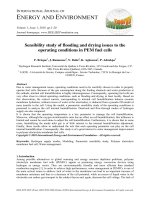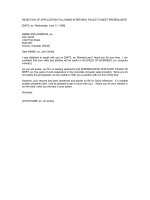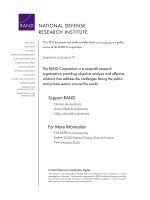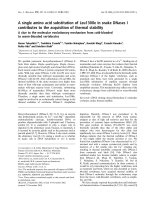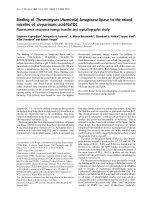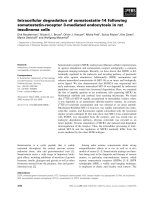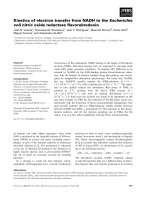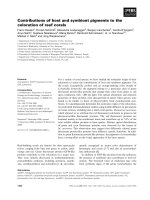Range Expansion Of Black Mangroves (Avicenna Germinans) To The Mi.pdf
Bạn đang xem bản rút gọn của tài liệu. Xem và tải ngay bản đầy đủ của tài liệu tại đây (333.76 KB, 5 trang )
Gulf of Mexico Science
Volume 31
Number 1 Number 1/2 (Combined Issue)
Article 8
2013
Range Expansion of Black Mangroves (Avicenna germinans) to
the Mississippi Barrier Islands
Whitney A. Scheffel
University of South Alabama
Kenneth L. Heck Jr.
Dauphin Island Sea Lab
Just Cebrian
Dauphin Island Sea Lab
Matthew Johnson
National Park Service
Dorothy Byron
Dauphin Island Sea Lab
Follow this and additional works at: />
DOI: 10.18785/goms.3101.08
Recommended Citation
Scheffel, W. A., K. L. Heck Jr., J. Cebrian, M. Johnson and D. Byron. 2013. Range Expansion of Black
Mangroves (Avicenna germinans) to the Mississippi Barrier Islands. Gulf of Mexico Science 31 (1).
Retrieved from />
This Article is brought to you for free and open access by The Aquila Digital Community. It has been accepted for
inclusion in Gulf of Mexico Science by an authorized editor of The Aquila Digital Community. For more information,
please contact
Scheffel et al.: Range Expansion of Black Mangroves (Avicenna germinans) to the Mi
SHORT PAPERS AND NOTES
Gulf of Mexico Science, 2013(1–2), pp. 79–82
E 2013 by the Marine Environmental Sciences
Consortium of Alabama
RANGE EXPANSION OF BLACK MANGROVES
(AVICENNIA GERMINANS) TO THE MISSISSIPPI BARRIER ISLANDS.—The expansion of
the black mangrove (Avicennia germinans) into Gulf
of Mexico salt marshes is among the many climateinduced poleward range shifts of tropically associated marine plants and animals that have been
documented in recent decades (Perry et al., 2005;
Lasram and Mouillot, 2009; Fodrie et al., 2010;
Comeaux et al., 2012). Gulf of Mexico salt marshes
are normally dominated by salt marsh cordgrass
(Spartina alterniflora) and black needlerush (Juncus
roemerianus). Some research suggests salt marsh
vegetation may actually facilitate black mangrove
seedling growth, with the marsh influence becoming neutral as mangrove seedlings mature (Guo et
al., 2013). While the distribution of black mangroves is limited by freezing temperatures in the
north, in warmer climates competition with mangrove species may limit salt marsh distribution
(Kangas and Lugo, 1990). Warmer winter temperatures and infrequent and less extreme frosts are
likely causes of the expansion of black mangroves
in the Gulf of Mexico (Sherrod and McMillan,
1985; Pickens and Hester, 2010; Cavanaugh et al.,
2014), and recent studies suggest there is a
temperature threshold for mangrove dominance
(Osland et al., 2013; Cavanaugh et al., 2014). In the
absence of freezes, mangroves have been shown to
channel large amounts of energy into production
and outcompete salt marshes by shading them
(Stevens et al., 2006). Although some studies in the
Gulf of Mexico have examined the effects of black
mangroves on nutrient cycling, decomposition
rates, and sediment accretion within recently
colonized salt marshes (McKee and Rooth, 2008;
Perry and Mendelssohn, 2009; Comeaux et al.,
2012), there is a lack of information on the broader
ecological changes these mangrove expansions
may have for species that inhabit salt marshes.
Recently, we have located black mangroves on
Horn and Cat Islands, which are part of the
Mississippi barrier island chain in the northern
Gulf of Mexico and, to the best of our knowledge, are the northernmost populations (Fig. 1).
We have located fewer than 10 black mangroves
on Horn Island and one tree on the northern
shore of Cat Island (Fig. 2). The mangroves on
Horn Island are the focus of a study to define
the effects that black mangroves have on the
abundance and secondary productivity of salt
marsh-associated taxa, such as penaeid shrimps,
blue crabs, smaller crustaceans, and juvenile
fishes. These macrofaunal species typically rely
on salt marshes of the northern Gulf as nursery
and foraging grounds. Because Spartina alterniflora exists lower in the intertidal zone and is
flooded more frequently and for longer durations than the black mangrove habitat, faunal
Fig. 1. (Left) Two black mangrove shrubs positioned at the mouth of Ranger Lagoon on Horn Island,
Mississippi (30.24171uN, 88.67886uW); (Right) Recently documented A. germinans residing in one of the inlets on
Cat Island, Mississippi (30.23037uN, 89.08532uW).
Gulf of Mexico Science goms-31-01-08.3d 12/6/14 08:44:40
Published by The Aquila Digital Community, 2018
79
Cust # 14-005
1
Gulf of Mexico Science, Vol. 31 [2018], No. 1, Art. 8
GULF OF MEXICO SCIENCE, 2013, VOL. 31(1–2)
Fig. 2. Presence of black mangroves along the Mississippi barrier island chain. Black dots indicate current known locations.
80
Gulf of Mexico Science goms-31-01-08.3d 12/6/14 08:44:50
/>DOI: 10.18785/goms.3101.08
80
Cust # 14-005
2
Scheffel et al.: Range Expansion of Black Mangroves (Avicenna germinans) to the Mi
SHORT PAPERS AND NOTES
species are able to use the salt marsh when
adjacent mangroves are dry (Patterson et al.,
1993; Rozas and Minello, 1998). Major alterations in habitat complexity through the expansion of black mangroves, therefore, could have
far reaching effects on economically important
fish and crustacean species (e.g., blue crab and
gray snapper), potentially altering both their
absolute and relative abundances. It is also
possible, however, that a combination of salt
marsh and mangrove habitats could prove to be
beneficial to organisms using these habitats
during alternating tidal stages (Caudill, 2005).
To begin to address these important ecological
questions, we are investigating the effects that
emergent black mangroves in the northern Gulf
of Mexico may have on salt marsh herbivory,
decomposition rates, plant morphometry, and
nutrient cycling. We will make comparisons to
faunal usage patterns at three sites within the
Chandeleur Islands, Louisiana, that have higher
abundances of black mangroves in the salt
marshes in relation to Horn Island. Since the
Chandeleur Islands have supported black mangroves for much longer, we can use a space-fortime substitution to predict changes likely to occur
as mangroves increase in abundance. Our work
will document community and ecosystem alterations due to climate change–induced colonization of salt marshes by black mangroves, especially
concerning the ‘‘nursery role’’ that marshes play
for economically important species. We plan to
continue surveying the barrier islands along the
northern Gulf coast to document future black
mangrove colonizations. These data will be crucial
for predicting the effects of mangrove expansion
on the harvest of finfish and crustaceans along
with changes in ecosystem structure and function
that are likely to occur as the conversion of marsh
to mangrove domination takes place.
Acknowledgments.—We thank the Marine Ecology
and Ecosystems labs at the Dauphin Island Sea Lab
(DISL) for their field and laboratory assistance. We
also thank the U.S. Fish and Wildlife Service, the
National Park Service Gulf Islands National Seashore, and the DISL for funding this project.
LITERATURE CITED
CAUDILL, M. C. 2005. Nekton utilization of black
mangrove (Avicennia germinans) and smooth cordgrass
(Spartina alterniflora) sites in southwestern Caminada
Bay, Louisiana. Master’s thesis, Louisiana State
University and Agricultural and Mechanical College,
Department of Oceanography and Coastal Sciences.
CAVANAUGH, K. C., J. R. KELLNER, A. J. FORDE, D. S.
GRUNER, J. D. PARKER, W. RODRIGUEZ, AND I. C. FELLER.
2014. Poleward expansion of mangroves is a threshold response to decreased frequency of extreme cold
events. Proc. Natl. Acad. Sci. 111(2):723–727.
COMEAUX, R. S., M. A. ALLISON, AND T. S. BIANCHI. 2012.
Mangrove expansion in the Gulf of Mexico with
climate change: Implications for wetland health and
resistance to rising sea levels. Estuar. Coast. Shelf Sci.
96:81–95.
FODRIE, F. J., K. L. HECK, S. P. POWERS, W. M. GRAHAM,
AND K. ROBINSON. 2010. Climate-related, decadal-scale
assemblage changes of seagrass-associated fishes in
the northern Gulf of Mexico. Glob. Change Biol.
16(1):48–59.
GUO, H., Y. ZHANG, Z. LAN, AND S. C. PENNINGS. 2013. Biotic
interactions mediate the expansion of black mangrove
(Avicennia germinans) into salt marshes under climate
change. Glob. Change Biol. 19:2765–2774.
KANGAS, P. C., AND A. E. LUGO. 1990. The distribution of
mangroves and salt marsh in Florida. Trop. Ecol.
31:32–39.
LASRAM, F. B. R., AND D. MOUILLOT. 2009. Increasing
southern invasion enhances congruence between
endemic and exotic Mediterranean fish fauna. Biol.
Invasions 11(3):697–711.
MCKEE, K. L., AND J. E. ROOTH. 2008. Where temperature meets tropical: Multi-factorial effects of elevated
CO2, nitrogen enrichment, and competition on a
mangrove-salt marsh community. Glob. Change Biol.
14(5):971–984.
OSLAND, M. J., N. ENWRIGHT, R. H. DAY, AND T. W. DOYLE.
2013. Winter climate change and coastal wetland
foundation species: Salt marshes vs. mangrove forests
in the southeastern United States. Glob. Change
Biol. 19(5):1482–1494.
PATTERSON, C. S., I. A. MENDELSSOHN, AND E. M. SWENSON.
1993. Growth and survival of Avicennia germinans
seedlings in a mangal/salt marsh community in
Louisiana, USA. J. Coast. Res. 9(3):801–810.
PERRY, A. L., P. J. LOW, J. R. ELLIS, AND J. D. REYNOLDS.
2005. Climate change and distribution shifts in
marine fishes. Science 308(5730):1912–1915.
PERRY, C. L., AND I. A. MENDELSSOHN. 2009. Ecosystem
effects of expanding populations of Avicennia germinans
in a Louisiana salt marsh. Wetlands 29(1):396–406.
PICKENS, C. N., AND M. W. HESTER. 2011. Temperature
tolerance of early life history stages of black mangrove Avicennia germinans: Implications for range
expansion. Estuar. Coasts 34:824–830.
ROZAS, L. P., AND T. J. MINELLO. 1998. Nekton use of salt
marsh, seagrass, and non-vegetated habitats in a south
Texas (USA) estuary. Bull. Mar. Sci. 63(3):481–501.
SHERROD, C. L., AND C. MCMILLAN. 1985. The distributional history and ecology of mangrove vegetation
along the northern Gulf of Mexico coastal region.
Contrib. Mar. Sci. 28:129–140.
STEVENS, P. W., S. L. FOX, AND C. L. MONTAGUE. 2006. The
interplay between mangroves and salt marshes at the
transition between temperate and subtropical climate in Florida. Wetlands Ecol. Manag. 14:435–444.
WHITNEY A. SCHEFFEL, KENNETH L. HECK, JR., JUST
CEBRIAN, MATTHEW JOHNSON, AND DOROTHY BYRON,
(WAS) University of South Alabama, Department of
Marine Sciences, 101 Bienville Boulevard, Dauphin
Gulf of Mexico Science goms-31-01-08.3d 12/6/14 08:44:52
Published by The Aquila Digital Community, 2018
81
81
Cust # 14-005
3
Gulf of Mexico Science, Vol. 31 [2018], No. 1, Art. 8
82
GULF OF MEXICO SCIENCE, 2013, VOL. 31(1–2)
Island, Alabama 36528, ; (KLH
and JC) Dauphin Island Sea Lab, University of South
Alabama, Department of Marine Sciences, 101
Bienville Boulevard, Dauphin Island, Alabama
36528; (MJ) National Park Service, Present address:
Bureau of Ocean Energy Management, 1201
Elmwood Park Boulevard, New Orleans, Louisiana
70123; (DB) Dauphin Island Sea Lab, Marine
Environmental Science Consortium, 101 Bienville
Boulevard, Dauphin Island, Alabama 36528. Send
reprint requests to WAS. Date accepted: February 12, 2014.
Gulf of Mexico Science goms-31-01-08.3d 12/6/14 08:44:52
/>DOI: 10.18785/goms.3101.08
82
Cust # 14-005
4
